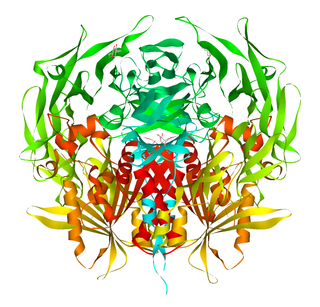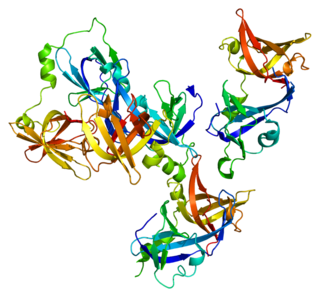
Cathepsin C (CTSC) also known as dipeptidyl peptidase I (DPP-I) is a lysosomal exo-cysteine protease belonging to the peptidase C1 protein family, a subgroup of the cysteine cathepsins. In humans, it is encoded by the CTSC gene.

Dipeptidyl peptidase-4, also known as adenosine deaminase complexing protein 2 or CD26 is a protein that, in humans, is encoded by the DPP4 gene. DPP4 is related to FAP, DPP8, and DPP9. The enzyme was discovered in 1966 by Hopsu-Havu and Glenner, and as a result of various studies on chemism, was called dipeptidyl peptidase IV [DP IV].

Leucyl/cystinyl aminopeptidase, also known as cystinyl aminopeptidase (CAP), insulin-regulated aminopeptidase (IRAP), human placental leucine aminopeptidase (PLAP), oxytocinase, and vasopressinase, is an enzyme of the aminopeptidase group that in humans is encoded by the LNPEP gene.

Tyrosine-protein kinase ITK/TSK also known as interleukin-2-inducible T-cell kinase or simply ITK, is a protein that in humans is encoded by the ITK gene. ITK is a member of the TEC family of kinases and is highly expressed in T cells.

Cartilage associated protein is a protein that in humans is encoded by the CRTAP gene.

Gamma-interferon-inducible protein Ifi-16 (Ifi-16) also known as interferon-inducible myeloid differentiation transcriptional activator is a protein that in humans is encoded by the IFI16 gene.

Egl nine homolog 2 is a protein that in humans is encoded by the EGLN2 gene. ELGN2 is an alpha-ketoglutarate-dependent hydroxylase, a superfamily of non-haem iron-containing proteins.

Fibroblast activation protein alpha (FAP-alpha) also known as prolyl endopeptidase FAP is an enzyme that in humans is encoded by the FAP gene.

Dipeptidyl-peptidase 3 is an enzyme that in humans is encoded by the DPP3 gene.

Dipeptidyl aminopeptidase-like protein 6 is a protein that in humans is encoded by the DPP6 gene.

40S ribosomal protein S10 is a protein that in humans is encoded by the RPS10 gene.

Attractin is a protein that in humans is encoded by the ATRN gene.

Dipeptidyl-peptidase 2 is an enzyme that in humans is encoded by the DPP7 gene.

Inactive dipeptidyl peptidase 10 is a protein that in humans is encoded by the DPP10 gene. Alternate transcriptional splice variants, encoding different isoforms, have been characterized.

Xaa-Pro aminopeptidase 1 is an enzyme that in humans is encoded by the XPNPEP1 gene.

Dipeptidyl peptidase 9 is an enzyme that in humans is encoded by the DPP9 gene.

Aminopeptidase B is an enzyme that in humans is encoded by the RNPEP gene.

Prolyl endopeptidase-like is an enzyme that in humans is encoded by the PREPL gene.

The PGPEP1 gene in humans encodes the enzyme Pyroglutamyl-peptidase I.
William W. Bachovchin is an American chemist/chemical biologist, academic and researcher. He is a professor of Molecular and Chemical Biology at Tufts University School of Medicine, and the founder of three biopharmaceutical companies: Point Therapeutics, Arisaph Pharmaceuticals, and Bach BioSciences.



















